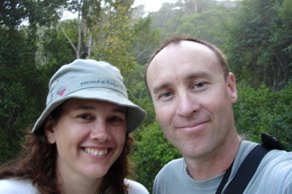Field Based Training --Jon
So, I just got back from spending three and a half days over at Aaron’s site (see links at left). I went with 4 other trainees, a Spanish teacher and a staff member. It was basically to get a good idea of how a volunteer functions in a community, and do to some real work and learn some different technical skills.
It was a lot of fun. The first day we just met our new families, and looked around the community. Also we took some time to work on a charla that we would give a few days later. The next day was the hardest, we worked to build several “acequias” which are fairly deep trenches running horizontal to the slope that has a level bottom to increase the infiltration of water into the soil, and also slows and captures the sediment from the sheet flows. This type of work reminded me of fire crew work, which made me approach it that way. I tried to get the trainees to work in a progressive manner as a team… only with moderate success.
The “finca” that we were working on was growing mainly oranges. We also built fruit fly traps to help protect the crop. Here, you harvest the oranges when they are still green (they are a variety that actually seems ripe and tastes good that way), if you wait until they ripen more, the fruit flies will have ruined most of the crop. The fly traps are fairly simple. You make them out of plastic bottles (of which there are all too many here) by cutting openings in the sides and putting orange juice in the bottom of the bottle as an attractant. The flies fly into the opening, hit the other side of the bottle, and fall and drown. The usual method includes adding urine to the juice to kill the flies in case they try to crawl out.
One of the bigger lessons during this exercise was learning about how to find the right kinds of landowners to work with. The farmer who had the oranges was a good example, he was slowly doing a lot of innovative things to the property. One reason was that he actually owned his land, therefore would see the results of labor that takes several years to produce changes. Many of the farmers here have to rent their land, and therefore do not see the value of any invested work beyond this years crop. Also farmers who have barely enough land to feed their family are not willing to take risks, so the more “spare” land a farmer has, the more willing he might be to try something new. A lot of my “work” during the first few months out on site will be to try to identify these types of people to focus my future projects on.
It was a lot of fun. The first day we just met our new families, and looked around the community. Also we took some time to work on a charla that we would give a few days later. The next day was the hardest, we worked to build several “acequias” which are fairly deep trenches running horizontal to the slope that has a level bottom to increase the infiltration of water into the soil, and also slows and captures the sediment from the sheet flows. This type of work reminded me of fire crew work, which made me approach it that way. I tried to get the trainees to work in a progressive manner as a team… only with moderate success.
The “finca” that we were working on was growing mainly oranges. We also built fruit fly traps to help protect the crop. Here, you harvest the oranges when they are still green (they are a variety that actually seems ripe and tastes good that way), if you wait until they ripen more, the fruit flies will have ruined most of the crop. The fly traps are fairly simple. You make them out of plastic bottles (of which there are all too many here) by cutting openings in the sides and putting orange juice in the bottom of the bottle as an attractant. The flies fly into the opening, hit the other side of the bottle, and fall and drown. The usual method includes adding urine to the juice to kill the flies in case they try to crawl out.
One of the bigger lessons during this exercise was learning about how to find the right kinds of landowners to work with. The farmer who had the oranges was a good example, he was slowly doing a lot of innovative things to the property. One reason was that he actually owned his land, therefore would see the results of labor that takes several years to produce changes. Many of the farmers here have to rent their land, and therefore do not see the value of any invested work beyond this years crop. Also farmers who have barely enough land to feed their family are not willing to take risks, so the more “spare” land a farmer has, the more willing he might be to try something new. A lot of my “work” during the first few months out on site will be to try to identify these types of people to focus my future projects on.


0 Comments:
Post a Comment
<< Home